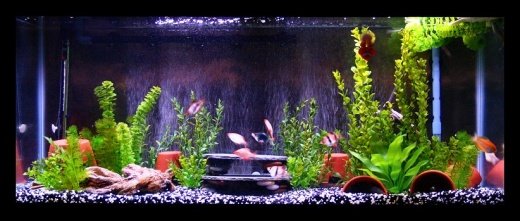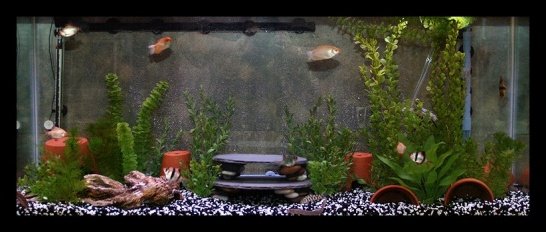How does that look on your tank ? do you think the shampoo will have any chance of drying out and leaving a film ?
Well, I didn't specifically use shampoo.
I had recently hung some reflective film on my garage doors. I had some of the spray left over, and thinking that was the adhesive, I used it to mount my background last night. I've since realized that the adhesive is actually on the film, and what I had left over was the wetting agent.
But then I got to realize that it wasn't the 'glue' that would be holding the background to the tank. What is really holding the backdrop is basically a suction cup... but in this case, the entire backdrop is acting like a flat suction cup. That is why the background has to be a little bit smaller than the tank, so the edges are not raised, and therefore there is no way for air to infiltrate between the glass and the backdrop.
Of course all this assumes the backdrop is plastic (impervious to water).
As for the shampoo/soap? Well for one, in theory, what little water is there should never dry unless the backdrop starts to pull away from the tank). And even if I'm wrong, I'm talking about using a very little amount of soap... not even a cap full in a gallon of water. Just enough to help break the water's surface tension. Think of the last time you ever did the trick of having a greesey bowl or sink full of water such that you could see an oil slick on the surface of the water. Now place a single drop of dish washing soap in the center, and watch the oil slick ZOOOOM away from the soap.
Now, I'll admit that this is all just a working theory. I have not seen the long term effects of doing this as I just applied my background yesterday. But when I just realized today that things worked great last night, and I didn't even actually use an adhesive, this is the logical conclusion and my educated guess at what should work fine.
Worst case, I'm wrong and you clean the dried soap off the back of the tank. If you are talking about a glass tank, I don't see how soap (especially baby shampoo) could harm the glass (or acrylic for that mater). If you are worried about the soap on acrylic, surely there is some sort of acrylic cleaner that could be used in the water rather than shampoo.
So I guess all I'm really talking about is an alternative to someone elses idea of using oil. The principle of why it works is basically the same, and the idea of the soap is just to break the surface tension of the water.


